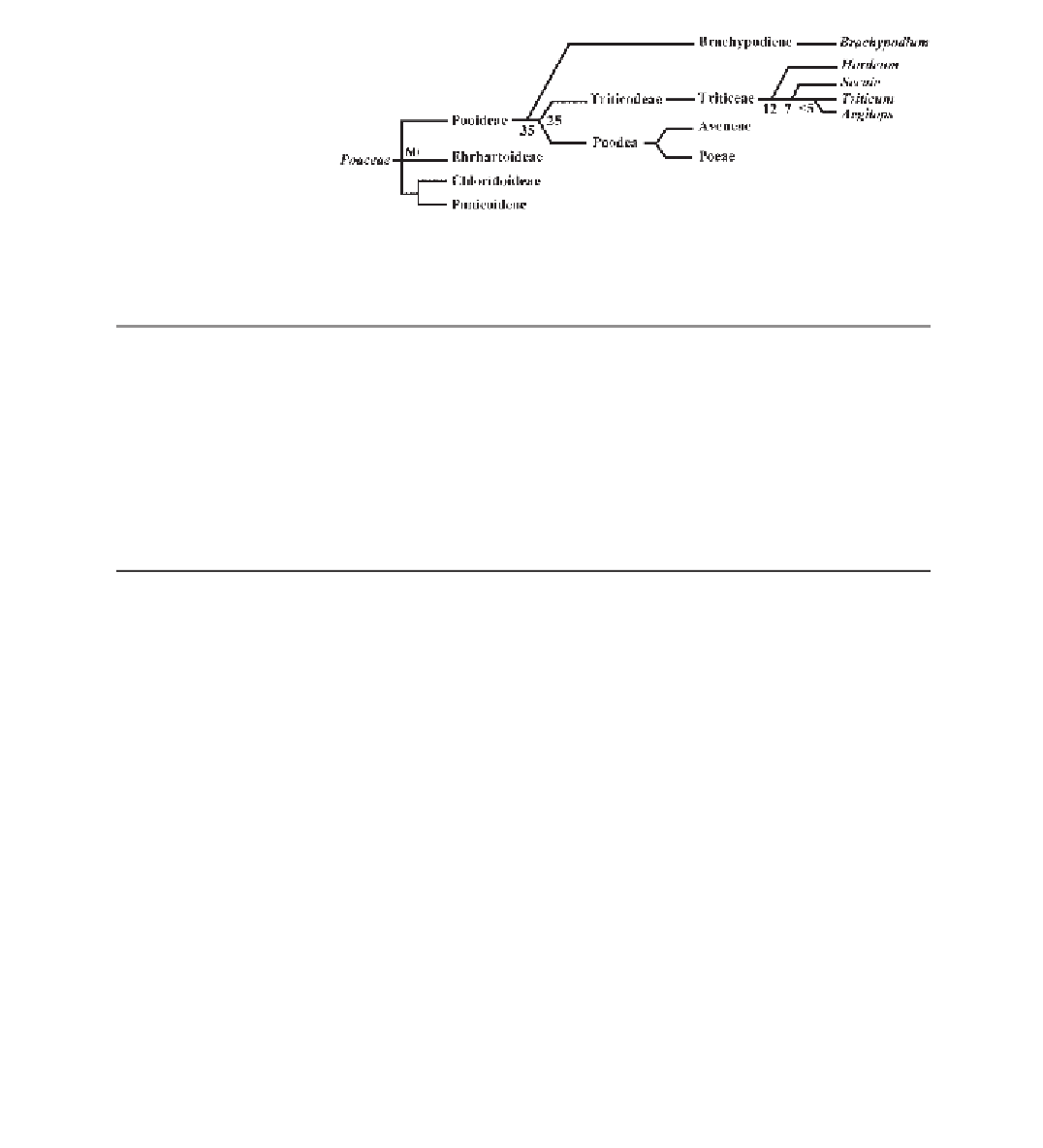Agriculture Reference
In-Depth Information
Fig. 15.1
Schematic repre-
sentation of the phylogenetic
relationship of the genus
Triti-
cum
to other grass species. The
approximate age of some of
the branching points is indi-
cated in millions of years ago
(MYA).
Table 15.1
Chromosomes involved in rearrangements in different Triticeae species.
Rearranged Chromosome Arm
a
Species
Type of Rearrangement
Wheat—A genome
4L, 5L
4AL-5AL and 4AL-7BS, translocations
Wheat—A genome
4A
Pericentric inversion
Wheat—B genome
7S
4AL-7BS, translocation
Wheat—D genome
—
Ae. speltoides
—
4S
a
L, 7S
a
L
4S
a
L-7S
a
L, translocation
Ae. longissima
Ae. umbellulata
1UL, 2U, 3US, 4US, 4UL,
5UL, 6US, 6UL, 7U
4UL-5UL, translocation; 2U and 7U, pericentric
inversions; others, translocations and inversions
c
Rye
2RS, 3RS, 4RL, 5RL, 6RL, 7RS,
7RL
4RL-5RL, 3RL-6RL, 4RS-7RL, 2RS-6RS, 6RS-7RL and
2RS-4RL, translocations; 6R, pericentric inversion
b
Barley
1HL
Paracentric inversion
H. bulbosum
1HL
Paracentric inversion
a
Rearrangements are described relative to the D genome of wheat.
b
Based on the model proposed by Devos et al. (1993).
c
Due to the complex structure of some of the
Ae. umbellulata
chromosomes, it was not possible to determine the nature
of all rearrangements that had taken place in the shaping of the
Ae. umbellulata
chromosomes.
the genomes of wheat and those of potential alien
gene donors, with the rationale that the level of
colinearity between donor and recipient genomes
would affect recombination and thus introgres-
sion of the alien fragment into the wheat
genome.
Homoeology between Triticeae chromosomes
had previously been established on the basis of
their ability to compensate for the loss of differ-
ent wheat chromosomes. In 1987, Naranjo and
colleagues identifi ed several chromosome regions
of rye that paired with nonhomoeologous wheat
chromosomes (Naranjo et al., 1987). Genetic
mapping of the rye genome using wheat RFLP
markers confi rmed that six of the seven rye chro-
mosomes had undergone reciprocal transloca-
tions and/or inversions relative to wheat (Devos
et al., 1993a). Similar comparative analyses of
wheat with barley (Dubcovsky et al., 1996),
Ae.
umbellulata
(Zhang et al., 1998),
Ae. longissima
(Zhang et al., 2001),
Hordeum bulbosum
(Salvo-
Garrido et al., 2001), and
Ae. speltoides
(Luo et
al., 2005) showed that large numbers of rearran-
gements were the exception rather than the norm.
Chromosomes of all but one species,
Ae. umbel-
lulata
, were either completely syntenic (
Ae.
speltoides
) or carried a single rearrangement (
Ae.
longissima
, barley, and
H. bulbosum
) relative to
the D genome of wheat. In
Ae. umbellulata
, all
seven chromosomes have been involved in at
least one translocation, resulting in single
Ae.
umbellulata
chromosomes having homoeology to
segments of four or more wheat chromosomes
(Zhang et al., 1998). A list of the chromosomes
involved in rearrangements in different Triticeae
species is given in Table 15.1. Most Triticeae
genomes, including the A, B, and D genomes,
have largely retained their ancestral confi gura-





